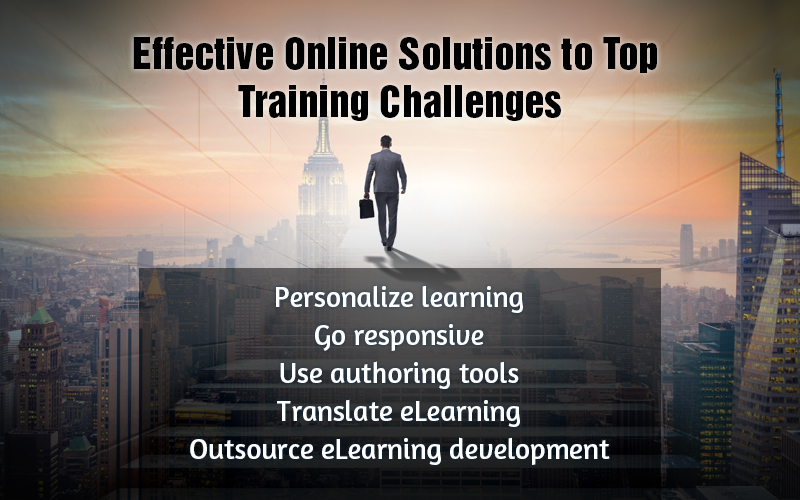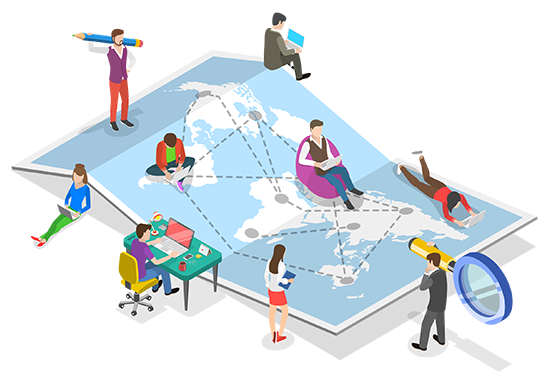5 Training Challenges of Growing Companies

What are successful companies doing that keeps them on the top of their competition? Two words: EMPLOYEE TRAINING.
One of the most important factors for competitive advantage is the employee learning strategy. Because of this, companies are always looking to hire and retain top talent, pumping billions into their corporate training programs to ensure they are ahead of the curve.
What are the Solutions to the Top 5 Training Challenges?
1. Challenge: Creating Training that Appeals to the New-age Learner
Solution: Personalize learning, set the content in context.
2. Challenge: Meeting the Demands of a Mobile Workforce
Solution: Opt for responsive learning.
3. Challenge: Coping with Increasing eLearning Development Costs
Solution: Use rapid authoring tools.
4. Challenge: Creating Consistent Training for a Global Workforce
Solution: Go for eLearning translations.
5. Challenge: Dealing with Lack of Resources & Technical Skills In-house
Solution: Outsource eLearning development.
Employee training has always been seen as a means to boost performance. However, the approach to developing and delivering training has dramatically changed over the years. With a change in approach come a slew of challenges training managers have to contend with.
Training managers in today’s world cannot focus only on imparting knowledge. They must also ensure the training is engaging, learner-centric, and performance-driven.
Added to this, all these have to be achieved as cost-effectively as possible.
There are also several other challenges that confront a training manager. Let’s look at those challenges and see how they can be handled.
Employee Training Challenges Faced by Training Managers
1. Challenge: Creating Training That Appeals to the New-age Learner
For far too long, paper-based materials formed the toolkit for employee training. Trainers along with learners were required to assemble in a brick-and-mortar classroom for hour- or day-long training sessions. These sessions had pre-determined schedules and syllabuses that every learner was forced to follow.
For today’s ‘new-age’ learners, however, a one-size-fits-all training paradigm is a strict no-no. So, what do they want?
- Learning to be personalized to their unique needs.
- Learning to be empathetic to their problems at work, offering solutions that will help boost their work performance.
- Access to learning on the very digital devices—smartphones and tablets—they carry around with them. (More on this later in the blog.)
What should you do?
Personalize their learning by addressing them by their name and giving them the freedom to navigate to the topic they wish to learn, instead of forcing them to go through every topic.
Reassure learners how the learning is going to addresses their work problems through well-defined performance-based objectives right at the beginning of the course. Learning activities too need to be designed bearing these LOs in mind, to maximize knowledge transfer and facilitate a performance-driven learning experience.
Set the learning content in context. Use real-world job tasks throughout the instructional material—examples, case studies. Use instructional strategies such as scenario-based learning that allow learners to immediately confront challenges they are likely to face at work, and witness the consequences of doing something incorrectly.

Incorporate games to heighten learner involvement and engagement. Learners like to participate, whether they are winning or losing. Games put the learner at risk and reward them for completing specific tasks.
Download these cool templates to spice up your eLearning for the new-age learners.
2. Challenge: Meeting the Demands of a Mobile Workforce
Here’s a stat for you: According to the Docebo Enterprise E-learning Trends 2020 report, nearly 57% of employees prefer accessing learning modules on the go.
This is what that stat translates to: new-age learners are mobile learners; they like learning on the go, on digital devices, be it smartphones or tablets.
They also prefer learning during their workflow, as opposed to being pulled off their work and disrupting the workflow.
What should you do?
To ensure courses are accessible on mobile devices, opt for responsive learning. Responsive learning enables the training content to be available on Android smartphones and tablets, iPhones, iPads, laptops, and desktops – making on-the-go learning a reality.

A successful responsive learning strategy should:
- Enable new-age learners to access learning at the moment of need
- Accelerate knowledge transfer/exchange
- Facilitate uninterrupted learning with offline capabilities
With responsive learning, it is also possible for organizations to offer just-in-time support to learners by hosting an online repository of bite-sized modules dealing with the critical points of a course.
Performance support can also be offered in the form of PDFs, infographics, and videos, to name a few. This way, when learners need access to specific information to finish a job task, they can just access the content they need instead of going through the entire course.
Note that responsive learning has little to do with the physical devices themselves. Rather, it is the experience and opportunity afforded by the evolution of mobile technologies. It is anywhere, anytime learning enabled by instant, on-demand access to a personalized training experience filled with the tools and resources required to finish job tasks.
3. Challenge: Coping with Increasing eLearning Development Costs
Scenario 1: Often times, companies need to deliver training at a rapid pace to keep their employees up-to-date with the latest information.
Trainings, especially on product knowledge, processes, and compliance are usually in high demand in any organization. A sales rep, for instance, cannot be expected to wait for training on an already launched new product; s/he needs the training “NOW”, s/he needs to be ready with product knowledge by the time it is launched.
Scenario 2: Organizations shifting from classroom to online learning have a treasure trove of training material in the form of PPTs, classroom training materials, or other paper-based manuals. These materials, instead of being discarded, can be leveraged for creating eLearning courses.
What should you do?
In both cases, creating courses from scratch is both cost-intensive and time-consuming — not if you are using rapid authoring tools, though.
Rapid authoring tools — Articulate Storyline, Adobe Captivate, or Lectora Inspire — are eLearning development tools which come with built-in ready-to-use templates and media asset libraries.
The pre-built templates provide the design framework for instructional designers to simply integrate content (classroom-based training content, for example) into it.
The template designs can be tweaked to comply with your style guide or corporate branding, and an ‘e-library’ can be created to reuse these templates as and when required, saving valuable development time and cost.
Rapid authoring tools also allow you to implement changes in existing courses without having to redesign them (scenario 2). This allows you to quickly develop and deliver courses to learners via the LMS/portal every time there is an update in the training content.
4. Challenge: Creating Consistent Training for a Global Workforce
To reach a globally dispersed workforce, training programs must be developed in a multitude of languages, bearing the cultural nuances in mind.
Furthermore, there are compliance laws, international laws, as well as regional laws to consider. Put simply, training employees around the globe takes an enormous amount of time, money, and more importantly, effort — it’s extremely complex.

What should you do?
To create consistent training for a global workforce, organizations can opt for authoring tools for their eLearning translations.
There’s two ways it can be done – translating them in-house or outsourcing to a vendor.
Doing it in-house implies investing in translation technology (authoring tools), while going to a vendor with their own translation software tools, translation experts, professional narrators, and efficient processes can lead to substantial savings.
Learn more about the benefits of outsourcing your translation requirements here.
5. Challenge: Dealing with Lack of Resources & Technical Skills In-house
Not all companies have a full, in-house training team with the technical know-how to handle all the nuances of developing and administering an effective training program.

What should you do?
In such cases, outsourcing eLearning development to an experienced vendor makes sense, as there are number of benefits attached to it, for instance:
- Access to experts in learning and instructional design, authoring tools, quality assurance, project management, and translations.
- Project management processes that vendors have in place that can scale up/down the development as and when required, all while cutting down the development time and cost as much as possible.
On the Whole
Training managers have their job cut out for them, as traditional, one-size-fits-all training is a thing of the past. With the emergence of new-age learning, training managers need to offer learner-centric, device-agnostic, performance-driven training, that can be developed and delivered as cost effectively as possible. Use these 5 tips to your advantage to ensure that the new-age learning needs are addressed!





